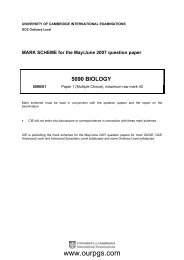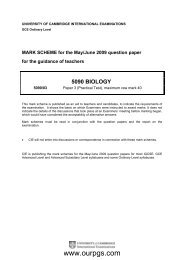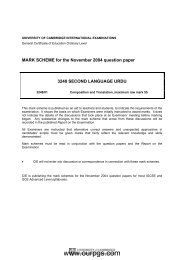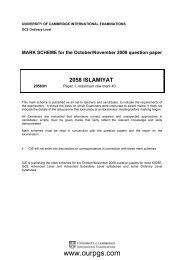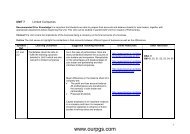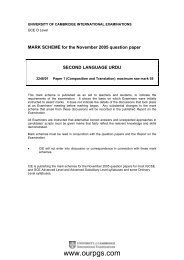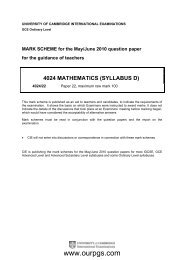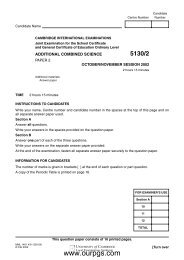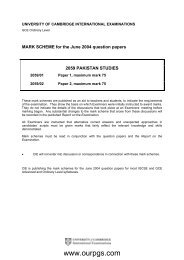Principles of Accounts-Scheme of work-6.pdf - Ourpgs.com
Principles of Accounts-Scheme of work-6.pdf - Ourpgs.com
Principles of Accounts-Scheme of work-6.pdf - Ourpgs.com
Create successful ePaper yourself
Turn your PDF publications into a flip-book with our unique Google optimized e-Paper software.
O Level <strong>Principles</strong> <strong>of</strong> <strong>Accounts</strong> (7110)Unit 6: Final <strong>Accounts</strong> – Partnerships: Limited Liability CompaniesRe<strong>com</strong>mended Prior KnowledgeIt is important that students are able to prepare final accounts and balance sheets for sole traders, together with appropriate adjustments before beginning this unit.ContextThis unit covers the impact <strong>of</strong> a partnership relationship on the final accounts <strong>of</strong> a business and the impact <strong>of</strong> incorporation on businesses.OutlineThe unit serves to highlight the similarities in final accounts between different types <strong>of</strong> business as well as the differences.AO Learning out<strong>com</strong>es Suggested Teaching activities Learning resources4.1 Candidates should be able to:• explain the advantages anddisadvantages <strong>of</strong> forming apartnershipCandidates should be able to:• outline the importance andcontents <strong>of</strong> a partnershipCompare the advantages and disadvantages <strong>of</strong> sole trader andpartnership businesses in terms <strong>of</strong> ownership, control and sources<strong>of</strong> finance.It can be useful to take the same information about fixed andcurrent assets and current liabilities as in the last example for a soletrader and simply show the capital accounts as being different. Thistreatment <strong>of</strong> the different type <strong>of</strong> business as a development <strong>of</strong> finalaccounts rather than something <strong>com</strong>pletely new will help studentsconcentrate on the new information.It is important that students understand that a partnership is abusiness in which two or more individuals have invested capital andit is the business pr<strong>of</strong>it as a whole that is calculated. They SHOULDNOT prepare separate columnar accounts splitting sales, purchase,expenses and so on between partners. Sharing <strong>of</strong> pr<strong>of</strong>its or lossestakes place after net pr<strong>of</strong>it is calculated.Explain what is meant by a partnership agreement and what itcontains. Explain the typical matters which will be defined in apartnership agreement covering matters such as the sharing <strong>of</strong>pr<strong>of</strong>its.http://www.tutor2u.net/revision_notes_accounting.aspPast question papers available from CIE,e.g.Specimen Paper 1 Q19http://www.bized.ac.uk/stafsup/options/accounting/<strong>work</strong>07.htmwww.ourpgs.<strong>com</strong>1
AO Learning out<strong>com</strong>es Suggested Teaching activities Learning resourcesagreement• explain the purpose <strong>of</strong> anAppropriation Account• prepare partnership Trading andPr<strong>of</strong>it and Loss <strong>Accounts</strong>,Appropriation <strong>Accounts</strong> andBalance Sheets• explain the uses and differencesbetween capital and currentaccounts• draw up partners’ current andcapital accounts, both in ledgerform, as part <strong>of</strong> a Balance Sheetpresentation• show the treatment <strong>of</strong> interest oncapital, partners’ salaries, intereston partners’ loans and ondrawings4.2 Candidates should be able to:• make simple entries for theformation <strong>of</strong> a partnership viacapital contribution by eachpartner in cash and/or non-cashassets and amalgamation <strong>of</strong> twosole traders, including theA key difference between partnerships andsole traders is the use <strong>of</strong> appropriation accounts. This is the part <strong>of</strong>the final accounts in which pr<strong>of</strong>its or losses are shared betweenpartners.Explain the reasons for and against using current accounts in apartnership and the implications <strong>of</strong> both on the bookkeeping.Illustrate and provide practice for students in preparing current andcapital accounts.It is helpful for students to increase the number <strong>of</strong> transactions inthe appropriation account steadily. Initially, begin with the sharing <strong>of</strong>pr<strong>of</strong>its. Then add partners’ salaries, the interest on capital anddrawings, gradually increasing the <strong>com</strong>plexity.Ensure students thoroughly understand the place <strong>of</strong> drawings andthat they do not appear in the appropriation account.Illustrate how sharing pr<strong>of</strong>it may not be equal because the capitalinjection may not be equal, or the <strong>com</strong>mitment <strong>of</strong> one partner to abusiness may be less in terms <strong>of</strong> management than another andthis is reflected in pr<strong>of</strong>it share.Students should be shown the calculation <strong>of</strong> goodwill as the surplus<strong>of</strong> purchase price over net assets. They should be able to accountfor goodwill and the net assets.http://accounting10.tripod.<strong>com</strong>/content.htmhttp://www.askltd.<strong>com</strong>/askjava/partners.htmPast question papers available from CIE,e.g.Jun 2003 Paper 1 Q31Jun 2005 Paper 1 Q32Nov 2002 Paper 2 Q3http://www.accaglobal.<strong>com</strong>/publications/studentaccountant/13217?session=fffffffeffffffffc28288ca40a137f0d9a9c4f8c6ad2017d5a4837ffa10d34fPast question papers available from CIE,e.g.www.ourpgs.<strong>com</strong>2
AO Learning out<strong>com</strong>es Suggested Teaching activities Learning resourcescalculation and recording <strong>of</strong>Nov 2003 Paper 1 Q21, 26Goodwill• make the other adjustments asdetailed under 4.1Questions will not be set on thedissolution <strong>of</strong> partnership.Explain and <strong>work</strong> through examples <strong>of</strong> goodwill and how it isincluded in accounts. Journal entries and ledgers should be fullycovered to prevent students reversing the entries. This is a <strong>com</strong>monerror in examination answers.Complete the study <strong>of</strong> partnerships by <strong>work</strong>ing through a full set <strong>of</strong>partnership final accounts and balance sheet.Students can be confused about when to use columnarcurrent/capital accounts. A consistent approach <strong>of</strong> using separatefull ledger accounts outside the balance sheet, bringing the closingbalance to the balance sheet is less confusing for students.http://www.bized.ac.uk/stafsup/options/accounting/<strong>work</strong>08.htmPast question papers available from CIE,e.g.Nov 2003 Paper 1 Q21, 26Jun 2004 Paper 2 Q5Jun 2006 Paper 2 Q54.5 Candidates should be able to:• prepare a simple limited <strong>com</strong>panyappropriation account• explain the capital structure <strong>of</strong> alimited <strong>com</strong>pany (<strong>com</strong>prisingpreference shares capital, ordinaryshare capital and retainedpr<strong>of</strong>its/pr<strong>of</strong>it and loss account) andhow it appears in the BalanceSheet• recognise the distinctions betweenauthorised, called-up, issued andpaid-up share capital and betweenshare capital – ordinary andpreference – and loan capital e.g.debenturesCandidates will not be required toThere are parallels with partnerships in thecase <strong>of</strong> the <strong>com</strong>pany appropriation account. In the case <strong>of</strong> a<strong>com</strong>pany the main transactions seen in the appropriation accountare proposed and paid dividends and transfers to and fromreserves.The structure <strong>of</strong> capital in a <strong>com</strong>pany can be <strong>com</strong>plex including notonly shares but also capital and revenue reserves. Illustrate andexplain the use <strong>of</strong> the <strong>com</strong>mon types <strong>of</strong> reserve and the <strong>com</strong>montypes <strong>of</strong> capital. Multiple choice questions are useful to helpstudents think through the variations.Time should be spent outlining the features and differencesbetween an ordinary share, a preference share and a debenture.Debentures are <strong>of</strong>ten regarded as part <strong>of</strong> ‘loan capital’ althoughloans rank as a creditor and not capital at all. It is important toemphasise this important distinction and its implications to students.It is important to clarify for students the extent <strong>of</strong> this syllabus sohttp://www.askltd.<strong>com</strong>/askjava/ltd<strong>com</strong>ps.htmPast question papers available from CIE,e.g.Nov 2003 Paper 1 Q35Jun 2003 Paper 2 Q3http://www.bized.ac.uk/dataserv/extel/notes/seq-ex.htmNov 2005 Paper 2 Q3Specimen Paper 1 Q36Specimen Paper 2 Q5http://www.bized.ac.uk/dataserv/extel/notes/ltl-th.htmhttp://www.bized.ac.uk/dataserv/extel/notes/lwww.ourpgs.<strong>com</strong>3
AO Learning out<strong>com</strong>es Suggested Teaching activities Learning resourcesprepare a <strong>com</strong>pany's Pr<strong>of</strong>it and LossAccount or a <strong>com</strong>plete Balance Sheet,to make entries to record the issue <strong>of</strong>capital, or to know the accountingrequirements <strong>of</strong> the Companies Acts.that they spend their course and home<strong>work</strong> time on matters <strong>of</strong>direct relevance.tl-ex.htmCandidates need to be aware <strong>of</strong>cumulative and non-cumulativepreference shares. They are notrequired to have an awareness <strong>of</strong>deferred, founders, participating,redeemable or ‘A’ shares, rightsissues, bonus issues, share premiumor capital redemption reserve.www.ourpgs.<strong>com</strong>4



